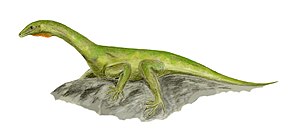Protorosauria
| Protorosauria | ||||||||||||
|---|---|---|---|---|---|---|---|---|---|---|---|---|

|
||||||||||||
| Temporal occurrence | ||||||||||||
| Upper Perm to Upper Triassic | ||||||||||||
| 258 to 200 million years | ||||||||||||
| Locations | ||||||||||||
| Systematics | ||||||||||||
|
||||||||||||
| Scientific name | ||||||||||||
| Protorosauria | ||||||||||||
| Lydekker , 1888 |
The Protorosauria or Prolacertiformes are an extinct group of basal archosaurs . They existed from the Upper Permian to the Upper Triassic . The animals were characterized by a more or less elongated neck, which was created by lengthening the individual cervical vertebrae and shifting the shoulder girdle backwards. Many representatives of the Protorosauria lived in aquatic environments , in and around water, while others, such as the Sharovipteryx , which was capable of gliding , lived on trees.
A particularly extreme representative of the Protorosauria is Tanystropheus longobardicus from the middle Triassic of the southern Alps . Individuals of this species were up to six meters long, of which about half made up the neck. The individual cervical vertebrae are up to 30 centimeters long and have a maximum diameter of five centimeters, the head is very small. Based on comparative anatomical studies, it is assumed that the neck was very stiff and could hardly be lifted above the body.
Systematics
- Protorosauria
literature
- Robert L. Carroll : Paleontology and Evolution of the Vertebrates. Thieme, Stuttgart et al. 1993, ISBN 3-13-774401-6 .
Web links
- Protorosauria / Prolacertiformes Mikko's Phylogeny Archive
Individual evidence
- ↑ Jerzy Dzik, Tomasz Sulej: An early Late Triassic long-necked reptile with a bony pectoral shield and gracile appendages. Acta Palaeontologica Polonica. Vol. 61, No. 4, 2016, pp. 805-823, doi: 10.4202 / app.2008.0065 .
- ^ Nicholas C. Fraser, Olivier Rieppel: A new protorosaur (Diapsida) from the Upper Buntsandstein of the Black Forest, Germany. In: Journal of Vertebrate Paleontology. Vol. 26, No. 4, 2006, pp. 866-871, doi : 10.1671 / 0272-4634 (2006) 26 [866: ANPDFT] 2.0.CO; 2 , p. 866
- ^ Andrey G. Sennikov: New tanystropheids (Reptilia: Archosauromorpha) from the Triassic of Europe. In: Paleontological Journal. Vol. 45, No. 1, 2011, pp. 90-104, doi: 10.1134 / S0031030111010151 (alternative full text access : ResearchGate ).
